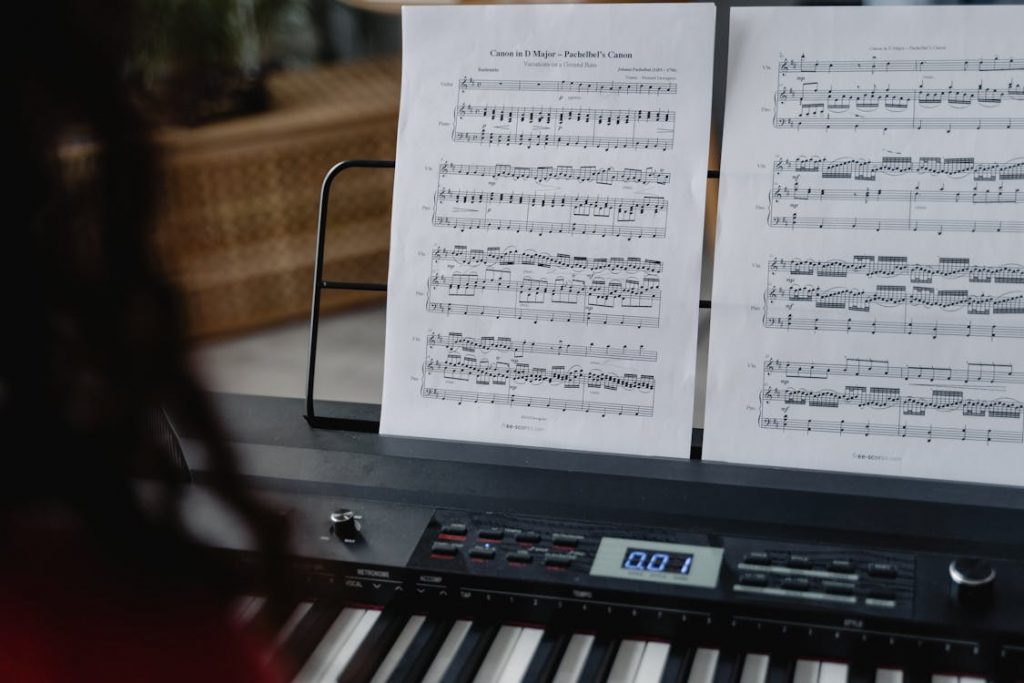One of the most exciting phases in your piano journey is the transition from beginner to intermediate. Once you realize that your skills are increasing and you are able to take on more challenging pieces, your motivation to continue progressing will often soar!
However, transitioning to a more intermediate level is not free of challenges – quite the opposite! Intermediate pianists will have to learn how to contend with more difficult music, changing hand positions, faster passages and more complex rhythms.
Learning to identify the best intermediate piano songs is an important part of developing to a more advanced pianist. This article aims to guide you in finding and mastering the best intermediate piano pieces, ensuring you continue to grow as a pianist.
- Fall in love with the music - Learn your favorite songs, at a level suitable for you.
- Enjoy interactive piano lessons - Explore courses covering music theory, technique chords & more.
- Get real-time feedback - Skoove's feedback tells you what went well and what needs practice.

Understanding intermediate piano songs
Intermediate piano pieces are compositions that require a moderate level of skill, more complex than easy piano songs but not as demanding as advanced works.
They often include a variety of technical challenges, such as varied hand positions, complex rhythms, and dynamic changes. These pieces are designed to help pianists transition smoothly to more advanced music.
The pieces can range from simplified versions of classical compositions to more complex works by contemporary composers. They typically involve the use of both hands independently, crossing over hands, and playing more intricate melodies and harmonies.
Examples include Beethoven’s Für Elise, Bach’s Inventions, and pieces by contemporary composers like Ludovico Einaudi.
Characteristics of intermediate piano pieces
Intermediate piano pieces typically feature extended hand positions that move beyond the five-finger patterns used in beginner pieces and often requiring more finger independence.
They incorporate more complex rhythms and a larger dynamic range to convey emotion and musical expression. Additionally, intermediate piano pieces use techniques like staccato, legato, and accents to add character to the music, requiring precise finger and hand control.
Finally, intermediate piano songs often introduce more sophisticated pedal techniques to sustain notes and enhance the sound quality of the music.
Differences between beginner, intermediate, and advanced levels
Before we go further, let’s explore the differences between beginner, intermediate, and advanced levels when learning how to play piano.
Beginner
Simple melodies, basic rhythms, and limited hand movement. Pieces are typically short and repetitive, focusing on fundamental skills such as reading music, basic hand coordination, piano scales, and elementary rhythms.
Intermediate
More complex rhythms, extended hand positions, and greater dynamic range. Pieces may involve multiple key changes, more advanced finger techniques and piano chords, and a deeper understanding of musical structure and expression.
Advanced
Highly complex rhythms, wide range of dynamics, intricate hand movements, and advanced techniques like trills, glissandi, and fast-paced passages. The hardest piano songs require a high level of technical proficiency and musical maturity.
Skill set required for intermediate piano pieces
To play intermediate pieces effectively, pianists need:
- Strong technical foundation: Proficiency in scales, arpeggios, and basic finger exercises to navigate more complex passages smoothly.
- Good sight-reading skills: Ability to read and interpret more complex musical notation, including multiple voices and varying rhythms. Remembering piano notes is required.
- Rhythmic accuracy: Understanding and executing various rhythmic patterns accurately, often requiring the use of a metronome to develop consistent timing.
- Expressive playing: Ability to convey emotion through dynamics, phrasing, and articulation, developing a more personal and nuanced interpretation of the music.
Finding the best intermediate piano pieces
Now let’s take a look at how you can go about finding the best intermediate pieces.
1. Sheet music books
Collections specifically for intermediate players. Books like “The Joy of Piano” series and “Piano Adventures” offer graded pieces that are carefully curated for different skill levels.
2. Learning apps
Apps like Skoove provide interactive lessons and a curated selection of intermediate pieces. These apps often include video tutorials, performance tips, and feedback on your playing.
3. Teacher recommendations
Experienced piano teachers can suggest suitable pieces based on your skill level. They can provide valuable insights into which pieces will best support your learning and development.
Tips on selecting pieces that match your skill level and musical taste
When choosing intermediate piano pieces, it is important to take into consideration your interests. Select pieces you enjoy and are motivated to learn. Playing music that resonates with you can make practice sessions more enjoyable and fulfilling.
Choose pieces that are challenging but not overwhelming. It’s important to select pieces that push your limits without causing frustration or discouragement. Include different styles and composers to broaden your musical experience. Exploring a range of genres can enhance your versatility and appreciation for different musical traditions.
Finally, it is useful to align your selections with your short-term and long-term objectives. Consider pieces that will help you develop specific skills or prepare you for future challenges.
Best intermediate piano pieces
Now, let’s explore some of the best intermediate piano pieces for you to check out, from many different musical styles. Many of these pieces are included in the Skoove app.
Classical repertoire
- Beethoven’s Für Elise: A well-known piece with a recognizable melody and varied dynamics. This piece is excellent for practicing finger dexterity and dynamic control.
- Bach’s Inventions: Short pieces that develop finger independence and articulation. Bach’s inventions are ideal for improving hand coordination and polyphonic playing.
- Chopin’s Preludes: Beautiful, expressive pieces that challenge both technique and musicality. Chopin’s preludes offer a rich exploration of Romantic-era piano music.
Modern repertoire
- Yann Tiersen’s Comptine d’un autre été: A minimalist piece with repeating patterns and subtle dynamics. This piece is great for practicing rhythmic consistency and expressive playing.
- Ludovico Einaudi’s Nuvole Bianche: A contemporary composition with lyrical melodies and rich harmonies. Einaudi’s music is known for its emotional depth and simplicity, making it accessible yet challenging.
Jazz and blues
- Duke Ellington’s Take the ‘A’ Train: A jazz standard that introduces syncopation and swing rhythm. This piece helps develop a sense of groove and improvisation skills.
- George Gershwin’s Summertime: A bluesy piece with expressive phrasing and blues scales. Gershwin’s music blends classical and jazz elements, offering a unique challenge.
Film and pop music
- John Williams’ Hedwig’s Theme: A magical, whimsical piece from the Harry Potter series. Williams’ music is known for its cinematic quality and complexity.
- Elton John’s Your Song: A beautiful pop ballad with rich chords and a memorable melody. This piece is excellent for practicing chordal playing and expressive phrasing.
You can take a look at some of these pieces being sampled by Tim, a piano teacher, in the video below. Get a visual guide on hand positioning, finger placement, and more, while learning popular pieces, such as Beethoven’s Für Elise.
Overcoming common challenges
Intermediate pianists often face a range of challenges that can make progress feel slow and frustrating.
One common issue is hitting a plateau in progress. This can be particularly disheartening when it feels like no matter how much you practice, you aren’t improving. The key to overcoming plateaus is to stay motivated and keep your practice routine varied and interesting.
Setting small, achievable goals can help maintain your enthusiasm and sense of accomplishment. For example, focus on mastering a difficult passage, or work on improving your tempo in a particular piece. Additionally, incorporating new pieces and techniques into your practice routine can keep things fresh and exciting, helping you break through the plateau.
Other common challenges and possible resolutions include:
Technical difficulties
Tackling tricky passages requires patience:
- Isolate difficult sections: Practice challenging parts separately. Focused practice on difficult sections helps you overcome specific technical challenges.
- Slow practice: Play slowly and gradually increase speed. Slow practice builds accuracy and confidence in difficult passages.
Performance anxiety
Performing in front of others can be nerve-wracking:
- Practice performing: Play for family and friends to build confidence. Regular performance practice helps you become more comfortable with performing.
- Relaxation techniques: Use deep breathing and visualization to calm nerves. Developing relaxation techniques can help you manage performance anxiety effectively.
Time management
Balancing practice with other commitments can be challenging:
- Set a schedule: Dedicate specific times for practice. Consistent practice schedules ensure regular progress.
- Prioritize: Focus on key areas that need improvement. Prioritizing your practice time helps you make the most of limited practice hours.
How Skoove can help you improve
Skoove is an excellent resource for pianists looking to master intermediate piano songs. The platform offers interactive lessons tailored to your skill level, making learning both engaging and efficient.
Whether you are just beginning to tackle intermediate pieces or looking to refine your technique, Skoove provides a structured approach to help you progress. Access to a vast library of intermediate pieces across various genres allows you to explore different musical styles and find pieces that interest you.
Real-time feedback on your playing and personalized guidance helps you identify areas for improvement and track your progress. Additionally, Skoove’s online piano lessons fit into any schedule, making it easy to practice consistently.
Take the step to the intermediate level today!
Becoming an intermediate pianist is an exciting time and learning intermediate piano songs is an important part of every pianist’s development. By carefully selecting and mastering these pieces, you can significantly enhance your technical skills, musical expression, and confidence.
Utilize resources like Skoove to discover new music and receive valuable feedback, ensuring you continue to grow and thrive as a pianist through all the stages of development!
Author of this blog post:
Susana Pérez Posada

With over seven years of piano education and a deep passion for music therapy, Susana brings a unique blend of expertise to Skoove. A graduate in Music Therapy from SRH Hochschule Heidelberg and an experienced classical pianist from Universidad EAFIT, she infuses her teaching with a holistic approach that transcends traditional piano lessons. Susana’s writings for Skoove combine her rich musical knowledge with engaging storytelling, enriching the learning experience for pianists of all levels. Away from the piano, she loves exploring new places and immersing herself in a good book, believing these diverse experiences enhance her creative teaching style.
Published by Lydia Hovan from the Skoove team















